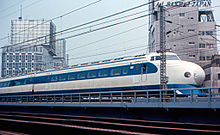The Shinkansen , colloquially known in English as the bullet train, is a network of high-speed railway lines in Japan. Initially, it was built to connect distant Japanese regions with Tokyo, the capital, in order to aid economic growth and development. Beyond long-distance travel, some sections around the largest metropolitan areas are used as a commuter rail network. It is operated by five Japan Railways Group companies.
Over the Shinkansen's 50-plus year history, carrying over 5.3 billion passengers, there has been not a single passenger fatality or injury due to train accidents.
Starting with the Tōkaidō Shinkansen (515.4 km, 320.3 mi) in 1964,the network has expanded to currently consist of 2,764.6 km (1,717.8 mi) of lines with maximum speeds of 240–320 km/h (150–200 mph), 283.5 km (176.2 mi) of Mini-Shinkansen lines with a maximum speed of 130 km/h (80 mph), and 10.3 km (6.4 mi) of spur lines with Shinkansen services.[5] The network presently links most major cities on the islands of Honshu and Kyushu, and Hakodate on northern island of Hokkaido, with an extension to Sapporo under construction and scheduled to commence in March 2031. The maximum operating speed is 320 km/h (200 mph) (on a 387.5 km section of the Tōhoku Shinkansen). Test runs have reached 443 km/h (275 mph) for conventional rail in 1996, and up to a world record 603 km/h (375 mph) for SCMaglev trains in April 2015.
The original Tōkaidō Shinkansen, connecting Tokyo, Nagoya and Osaka, three of Japan's largest cities, is one of the world's busiest high-speed rail lines. In the one-year period preceding March 2017, it carried 159 million passengers, and since its opening more than five decades ago, it has transported more than 5.6 billion total passengers. The service on the line operates much larger trains and at higher frequency than most other high speed lines in the world. At peak times, the line carries up to thirteen trains per hour in each direction with sixteen cars each (1,323-seat capacity and occasionally additional standing passengers) with a minimum headway of three minutes between trains.
Japan's Shinkansen network had the highest annual passenger ridership (a maximum of 353 million in 2007) of any high-speed rail network until 2011, when the Chinese high-speed railway network surpassed it at 370 million passengers annually, reaching over 1.7 billion annual passengers in 2017,though the total cumulative passengers, at over 10 billion, is still larger. While the Shinkansen network has been expanding, Japan's declining population is expected to cause ridership to decline over time. The recent expansion in tourism has boosted ridership marginally.
| Tokaido | Tohoku | San'yō | Joetsu | Nagano | Kyushu | Hokkaido | Sum* | Total (excl. transfers) | |
|---|---|---|---|---|---|---|---|---|---|
| FY2007 | 151.32 | 84.83 | 64.43 | 38.29 | 10.13 | 4.18 | - | 353.18 | 315.77 |
| FY2015 | 162.97 | 90.45 | 72.06 | 42.96 | 31.84 | 13.65 | **0.10 | 414.03 | 365.71 |
| FY2016 | 167.72 | 91.09 | 72.53 | 43.06 | 30.75 | 13.27 | 2.11 | 420.53 | |
| FY2017 | 170.09 | 91.98 | 74.46 | 43.80 | 31.03 | 14.24 | 2.19 | 427.78 |
The sum of the ridership of individual lines does not equal the ridership of the system because a single rider may be counted multiple times when using multiple lines, to get proper ridership figures for a system, in the above case, is only counted once.
Only refers to 6 days of operation: 26 March 2016 (opening date) to 31 March 2016 (end of FY2015).
Until 2011, Japan's high-speed rail system had the highest annual patronage of any system worldwide, China's HSR network's patronage reached 1.7 billion and is now the world's highest.
source: google imagessource:google images
source:google images
source: google images
History
Japan was the first country to build dedicated railway lines for high-speed travel. Because of the mountainous terrain, the existing network consisted of 1,067 mm (3 ft 6 in) narrow-gauge lines, which generally took indirect routes and could not be adapted to higher speeds. Consequently, Japan had a greater need for new high-speed lines than countries where the existing standard gauge or broad gauge rail system had more upgrade potential.
Among the key people credited with the construction of the first Shinkansen are Hideo Shima, the Chief Engineer, and Shinji Sogō, the first President of Japanese National Railways (JNR) who managed to persuade politicians to back the plan. Other significant people responsible for its technical development were Tadanao Miki, Tadashi Matsudaira, and Hajime Kawanabe based at the Railway Technical Research Institute (RTRI), part of JNR. They were responsible for much of the technical development of the first line, the Tōkaidō Shinkansen. All three had worked on aircraft design during World War II.
source: wikipedia







No comments:
Post a Comment